Dell 2407WFP and 3007WFP LCD Comparison
by Jarred Walton on March 2, 2007 11:30 AM EST- Posted in
- Displays
Brightness and Contrast Comparisons
For testing, we used a Monaco Optix XR (DTP-94) colorimeter on the hardware side. For software, we used Monaco Optix XR Pro. The software and hardware are relatively easy to use and together they help users fine tune their displays. Before we get to the calibrated results, we took a quick look at how the displays performed at minimum and maximum brightness. Note that we retested all of the displays here for this article, as we adjusted our testing procedures slightly in order to make sure we were providing the most consistent results possible. If you refer back to our previous Gateway FPD2485W article, you'll notice slight differences in the scores we are reporting today.
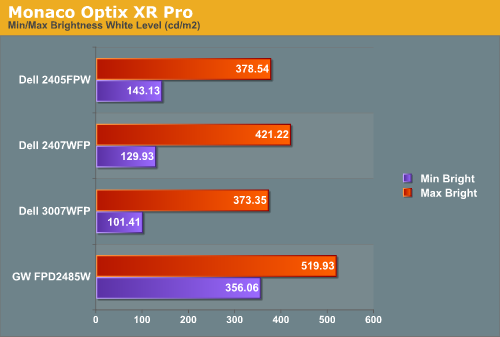
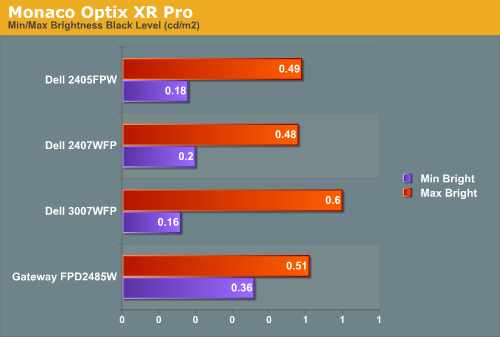
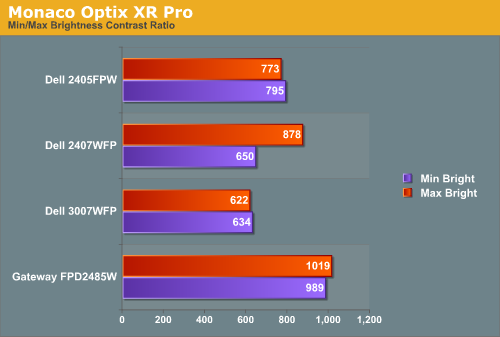
All three of the Dell LCDs are relatively consistent in terms of brightness levels and contrast ratios. The Gateway FPD2485W on the other hand is clearly brighter than the other LCDs, and it also has a higher contrast ratio. As we mentioned in the Gateway review, however, looking at these numbers really doesn't tell you a whole lot about how a display really performs. In the case of the Gateway LCD, even at minimum brightness it can feel overly bright in some environments. Now let's take a look at the brightness levels and contrast ratios once we've calibrated the LCDs.
We did find that the Monaco Optix XR Pro instructions tend to be a bit aggressive in terms of setting the contrast ratio, but both of the Dell LCDs we're looking at today don't provide an option to adjust contrast. For reference, the Gateway LCD was set to a 60% contrast ratio instead of 100% as the reduced contrast level generated slightly better overall results.
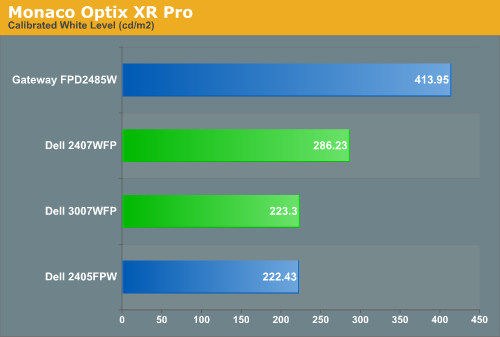
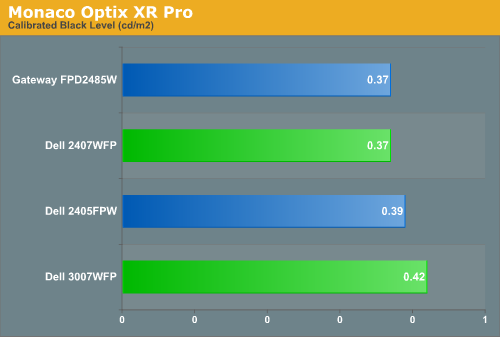
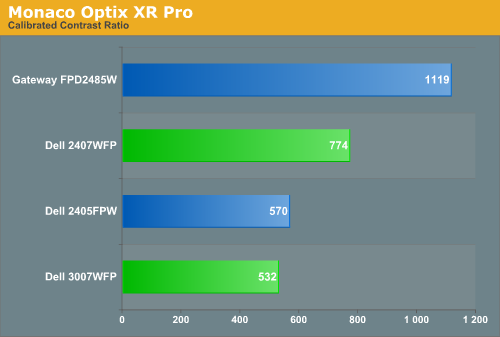
Comparing the calibrated versus min/max brightness, it should be immediately apparent that for most uses you will want to turn down the brightness level. As we'll see on the next page, you can still get good color accuracy even with a bright display, but if you use your computer for long periods at a time a display that's too bright can cause headaches and other annoyances. Theoretically, you want your whites to be brighter and your blacks to be darker, but brighter whites are only good up to a certain point. Anything above 400 cd/m 2 is far too bright in our opinion, and we found all three Dell LCDs tended to feel a bit easier on the eyes. Personal preference will still play a role, however, so if you find that you like really bright displays you might prefer the Gateway LCD.
For testing, we used a Monaco Optix XR (DTP-94) colorimeter on the hardware side. For software, we used Monaco Optix XR Pro. The software and hardware are relatively easy to use and together they help users fine tune their displays. Before we get to the calibrated results, we took a quick look at how the displays performed at minimum and maximum brightness. Note that we retested all of the displays here for this article, as we adjusted our testing procedures slightly in order to make sure we were providing the most consistent results possible. If you refer back to our previous Gateway FPD2485W article, you'll notice slight differences in the scores we are reporting today.



All three of the Dell LCDs are relatively consistent in terms of brightness levels and contrast ratios. The Gateway FPD2485W on the other hand is clearly brighter than the other LCDs, and it also has a higher contrast ratio. As we mentioned in the Gateway review, however, looking at these numbers really doesn't tell you a whole lot about how a display really performs. In the case of the Gateway LCD, even at minimum brightness it can feel overly bright in some environments. Now let's take a look at the brightness levels and contrast ratios once we've calibrated the LCDs.
We did find that the Monaco Optix XR Pro instructions tend to be a bit aggressive in terms of setting the contrast ratio, but both of the Dell LCDs we're looking at today don't provide an option to adjust contrast. For reference, the Gateway LCD was set to a 60% contrast ratio instead of 100% as the reduced contrast level generated slightly better overall results.



Comparing the calibrated versus min/max brightness, it should be immediately apparent that for most uses you will want to turn down the brightness level. As we'll see on the next page, you can still get good color accuracy even with a bright display, but if you use your computer for long periods at a time a display that's too bright can cause headaches and other annoyances. Theoretically, you want your whites to be brighter and your blacks to be darker, but brighter whites are only good up to a certain point. Anything above 400 cd/m 2 is far too bright in our opinion, and we found all three Dell LCDs tended to feel a bit easier on the eyes. Personal preference will still play a role, however, so if you find that you like really bright displays you might prefer the Gateway LCD.










62 Comments
View All Comments
Zebo - Friday, March 2, 2007 - link
The HC is still IPS and even better this time covering 93% of adobe color gamet vs 72% past model and it's more overdriven making it faster. Inputs are still lame with DVI only.Right now only corp customers can get the HC.
There is a non technical review floating around the net with nice pics..hot hardware I think.
acivick - Friday, March 2, 2007 - link
As nice as these monitors are, it seems to be that no one is really releasing any new 4:3 or 5:4 monitors anymore. Everything is widescreen. Sure, I think it's great when you're watching movies, but that's why I have a widescreen TV.I primarily use my PC for office work and games, neither of which really lend themselves to widescreen very well. Maybe a lot of newer games are coming out with widescreen support, but a good number don't offer it, at least officially.
Maybe I'm just a minority now, since every company seems to be focusing on it. Anyone else with similar opinions?
JarredWalton - Friday, March 2, 2007 - link
I definitely prefer WS displays, even outside of gaming. The ability to easily put two full pages of text next to each other is nice, and it's one of the reasons I don't find portrait mode on larger WS LCDs to be useful. I just wish more games were properly (i.e. natively with proper aspect ratio) supporting widescreen modes. On smaller displays, however, I'm not as big a fan of WS - I'd prefer a 19/20" standard AR over a 19/20" WS display. Basically, if you can't get at least 1680x1050 I'd just as soon stick with a normal AR.yyrkoon - Friday, March 2, 2007 - link
Personally, I think it would be good to include power usage of LCD monitors you're testing. I know you guys have the equipment already, and this is one of a few reasons why people use LCD vs CRT. Is this information in the article aready ? IF so, I missed it . . .mongo lloyd - Saturday, March 3, 2007 - link
Lower power consumption with LCDs is mostly a myth nowadays when you're moving up to the bigger and/or brighter monitors. As you can see with the specs here, both these monitors eat as much as (in the case of the 24") and more power than (in the case of the 30") a 21-22" CRT (most commonly ~125 W). The few business-oriented CRTs that are still available usually draw around 75-85 W, which many LCDs do as well.So that "benefit with LCD monitors" is also questionable...
JarredWalton - Friday, March 2, 2007 - link
It's listed on the specs tables, although those are manufacturer figures. They're generally accurate, however, with a pure white output using more power than a black output. I'll see about adding a quick test of min/max/avg power use on future reviews, though - thanks for the suggestion.tmok2007 - Friday, March 2, 2007 - link
Sorry, the 3007WFP is selling for $1,350. Where can I find a 37" or 42" 1080p LCD TV for less than this?timmiser - Friday, March 2, 2007 - link
The Westinghouse 37" model is available at Newegg for $999.JarredWalton - Friday, March 2, 2007 - link
Check Google/Froogle: Westinghouse makes a 1080p 42" that starts at around $1300, and the 37" is slightly less IIRC.exdeath - Friday, March 2, 2007 - link
Could we add the 2707WFP in there?Its a 27" compromise between the wider range of capabilities of the 30" and the smaller size of the 24"
Single link 1920x1200 with a built in scaler (and thus multiple inputs) but larger than the 24". 1920x1200 is also more manageable for gaming, as even with 8800 SLI some games just can't run fast and smooth enough at 2560x1600.
As for the .303mm pixel pitch, keep in mind that a 19" 4:3 1280x1024 screen that I would wager is the most common LCD in use right now is like .295mm and I never heard anyone complaining about the 19" displays... I think breaking the .3xx barrier is more of a psychological effect of seeing a "3" in the dot pitch spec more than anyone being truly disturbed by perceived graininess. Also, the 37" and 42" screens people love for their HDTVs are like .85mm pitch...
Anyone, could you maybe update later with the 2707WFP as well? I'm considering getting one, and the metal and glass trim would go well with my ATC111 and glass desk :)